ICT infrastructure projects
This is where projects are presented that the SDIG has promoted in the past.
MARE - Central App for management and billing of research projects

Faculty of Medicine
The processing and invoicing of research contracts at the DBMR is currently complicated and inefficient due to the lack of a central application. The project aims to develop a modular online application called MARE that standardizes and automates the management of research contracts and infrastructure. The aim is to increase efficiency, reduce costs and make optimum use of resources.
Quality Intelligence – 1. part BFS data on university graduates

Vice-Rectorate Quality
The University of Bern has been analyzing FSO data on university graduates since 2009, but the reception of the comprehensive reports is low. The project aims to improve data processing and enable a target group-oriented and graphically prepared presentation through the use of business intelligence software such as PowerBI. The aim is to increase the use of data for strategic decisions and curriculum development and to promote a data-driven culture.
Automated capture of informations on dissertations UB

University Library of Bern UB
The University Library of Bern receives around 500 printed dissertations every year, which are time-consuming to enter manually and tie up human resources. The project aims to automate this process using an AI-supported solution in order to make the dissertations available in the library system more quickly and efficiently. This should relieve the burden on staff and allow resources to be used for other tasks.
VIBE: Virtual Imaging at UniBE

MIC & DSL
The University of Bern needs a central platform for processing and analyzing bioimaging data, as existing solutions are fragmented and inefficient. The VIBE project aims to create an interactive, user-friendly platform that provides high-performance computing resources and pre-installed software for image analysis. The aim is to accelerate research, create synergies and optimize energy consumption.
Information security: strategy and implementation

Faculty of Medicine
The institutes of the Faculty of Medicine at the University of Bern manage particularly sensitive data and therefore require a comprehensive information security strategy. The project aims to develop and implement such a strategy with the involvement of external expertise in order to meet the increased data protection requirements. The aim is to raise security standards and exploit synergies within the university by making the documents developed available to other institutes.
Procurement and extension of KI-GPUs

IT Services Office
The University of Bern is experiencing an increasing demand for specialized AI graphics processing units (GPUs), which are essential for research and teaching but very expensive to purchase. The project provides for the procurement of two H100 AI GPU nodes to make this technology accessible to all researchers and teachers and to improve computing resources. The aim is to increase the quality of research and teaching and to use the infrastructure more efficiently.
Christian Lehmann
IIIF- and TEI-Publisher Services Data Storage

University Library of Bern UB
Various projects make image and text material available interoperably for use in presentation platforms. The University of Bern already offers services for the interoperable use of image and text material, but there is a lack of reliable information on storage capacity and the associated costs, which makes it difficult to onboard new projects. As part of a four-year pilot project, during which the use of the IIIF and TEI infrastructure will be made available free of charge, experience will be gained with the data volumes and usage and sustainable cost models will be developed in the long term.
Virtual room UniBE

Communication and Marketing Office
The University of Bern is planning to create a virtual space in the Metaverse to hold Bachelor's and Master's info days and other events digitally. The aim is to develop an innovative and interactive platform that promotes exchange and encounters while increasing the visibility of the university. By using this technology, costs and dependencies on external service providers are to be reduced.
Further development of STACK plugin

Phil.-Nat. Faculty
The University of Bern has been using the STACK plugin for ILIAS since 2020 to develop interactive digital tasks in various courses, but this requires continuous adaptation and further development. The project aims to further maintain the plugin and integrate new functionalities to expand the didactic possibilities. This should enable teachers and students to benefit from improved digital learning resources and increase the quality of teaching.
Analysis of business processes of the Medical Faculty

Faculty of Medicine & IT Services Office
The Faculty of Medicine at the University of Bern needs a modern solution to support its teaching performance and research evaluation, as the existing in-house developments in FACTScience can no longer be maintained. The project envisages the development of a user-friendly data warehouse that brings together data from various sources and offers comprehensive evaluation options. In a first step, the business processes of the Faculty of Medicine are to be analyzed in order to lay the foundation for the development of a corresponding IT solution.
Lukas Stalder & Eliane Salomon
Training MS Teams Vetsuisse

Vetsuisse
The Faculty of Veterinary Medicine at the University of Bern has stepped up its use of Office 365 to improve collaboration and communication, but many employees are not yet using the tools to their full potential. The project provides training at various levels to ensure that everyone involved can use the functions of Microsoft Teams, SharePoint and OneDrive effectively. The aim is to increase employees' digital skills and improve the efficiency of work processes.
Licence “Dimensions”

Vice-Rectorate Research and Innovation & University Library of Bern UB
The University of Bern needs a new database for research evaluation, as the previous solution no longer meets current requirements. The project aims to renew the database by using the Dimensions database in order to obtain reliable key research figures and reduce dependence on outdated databases. In the medium term, the data is to be merged into a data warehouse.
Competence management system

Learning and Development | LEAD
The University of Bern needs a flexible skills management system to visualize and support students' individual skills development in personalized learning paths. The project aims to develop a tool that maps skills profiles and displays student progress in real time to enable better student advising and program management. This should improve the quality of teaching and make it easier for students to navigate their studies.
Fit for Europe - Teaching

Vice-Rectorate Teaching
The University of Bern is striving for greater integration into the European Higher Education Area in order to promote mobility and cooperation in studies. The project aims to adapt the university's IT systems so that they support rather than hinder the exchange of data with European partners. This should strengthen the University of Bern's position in the European higher education landscape and provide students with a seamless international experience.
Platform-as-a-Service (PaaS) with dedicated team

IT Services Office
Applications are operated in IT organizations at the University of Bern. Despite similar requirements for application operation, there is a tendency towards individual solutions and specific infrastructure. The University of Bern is now planning to build a platform that supports application operations from deployment to operation. The platform should decouple infrastructure and application logic from each other and be supported as a service by a platform team.
Project Manager Teaching Hub

Vice-Rectorate Teaching
The establishment of the “Teaching Hub” as a centralized information access for digital teaching is intended to offer lecturers easily accessible and time-saving offerings. The site integrates information in a user-friendly manner and offers an intelligent search function.
Campus license Mentimeter

Vice-Rectorate Teaching
(Classic) frontal teaching still plays a major role for lecturers, especially at large events such as lectures. Audience response systems such as Mentimeter enable the activation and inclusion of the audience at events such as lectures, conferences or meetings. The University of Bern is purchasing a campus license from Mentimeter (initially as a test for two years) to enable more interaction in lectures and events.
Setting up project management for digital transformation (Vetsuisse)

Vetsuisse
The Vetsuisse Faculty plays a pioneering role in digital transformation in teaching and some research areas. However, there is a lot of catching up to do, particularly in the areas of IT security, data warehousing and the empowerment of data suppliers. Central project management is intended to support the planning and implementation of these projects.
ICT architect for the Medical Faculty

Faculty of Medicine
Various ICT projects are currently underway at the interface between the medical faculty and the Insel hospital. The Medical Faculty needs an ICT solution architect who will analyze the ICT architecture and design sensible variants for its design. After the initialization phase, this architect will continue to support the projects, including conception, tests, changes and acceptance.
Data center strategy University of Bern

IT Services Office & Facility Management Office
The spatial and physical structures of the University of Bern's IT systems have grown historically. Today it operates around 30 small and medium-sized server rooms in its buildings. The University of Bern is now planning a strategic development of its IT structures, especially the server rooms. The concentration of operations in two data centers will be examined and the possibility of (partial) outsourcing to professional, external data centers will be considered.
Pilot use of SDSC research infrastructure

Vice-Rectorate Research and Innovation
The need for collaborative data science projects and the implementation of joint projects with a strong data science orientation is increasing. The Swiss Data Science Center (SDSC) will exist as a national infrastructure from 2025. Its future use in such data science projects will be tested by researchers at the University of Bern in 5 to 10 pilot projects from various disciplines. The results from the projects will be presented at a symposium on 6.11.2024. More information:
Immediate measures IT structures Phil.-hist. Faculty

Phil.-hist. Faculty
The central IT of the Phil.-hist. faculty already looks after seven institutes and centers as well as the dean's office. In order to improve their systems, to introduce digital working methods and to put IT on a solid basis, additional resources are needed. The aim is to further develop the central IT so that it can also provide IT support for the remaining institutes of the faculty in the future.
Making Opencast & Tobira future-proof

iLUB
The University of Bern uses Opencast and Tobira to record lectures and provide videos. The goal is to optimize these platforms to make them a central point of contact for all audio-visual media in teaching, while ensuring accessibility.
Usability improvements in ILIAS

iLUB
ILIAS, the learning management system of the University of Bern, offers a wide range of functions for teachers and students. However, usage is not always intuitive. The goal is to measurably improve the user-friendliness and accessibility of ILIAS and thus make it easier to use the diverse functions.
Capacity Storage

IT Services Office
Climate research is one of five key topics according to the Strategy 2030. Based on the need for the climate research group to replace existing storage systems, a service for the cost-effective storage of large amounts of data in the petabyte range is to be developed, which will be made accessible to all university units.
Christian Lehmann
